Content
- 1 What does tuna look like and where is it found?
- 2 Types of tuna
- 3 The chemical composition of tuna
- 4 Nutritional value and calorie content of tuna
- 5 Why tuna is useful for the body
- 6 Tuna for weight loss
- 7 Can pregnant and lactating women eat tuna?
- 8 At what age children can be given tuna
- 9 Is tuna good for diabetes and pancreatitis?
- 10 The benefits and harms of canned tuna
- 11 Features of eating tuna
- 12 How to cook delicious tuna
- 13 Harm of tuna and contraindications for use
- 14 How to choose and store canned tuna
- 15 Conclusion
- 16 Reviews
Today, the benefits and harms of tuna are widely discussed. To deal with this question, you need to know what it is about: why this fish is so prized.
What does tuna look like and where is found
Tuna are seven species of oceanic fish that make up the genus Thunnus and are of great commercial value. They can differ significantly from each other. The description of tuna can be presented as follows: their carcasses are rounded, tapering to a tail section bifurcated by a crescent. They have a color from dark on top to silvery down.
Another notable feature of the species is that the subcutaneous blood vessels have a developed network, representing a unique temperature regulator, which is necessary to maintain it above the environment due to the slow swimming mode.
Tuna is a migratory species that can travel thousands of kilometers of ocean throughout its life. It is mined in various regions around the world. Today, more than 70 countries are engaged in its extraction, including the USA, Japan and Spain.
Tuna is found in all ocean waters except polar waters, but most of the world's catch comes from the Pacific Ocean, which accounts for about 66 percent.
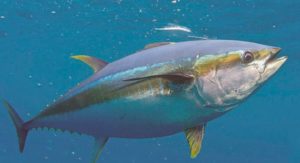
Types of tuna
Only seven species of this fish are the object of commercial fishing. These include:
- Common or blue-fin (Thunnus thynnus). It has a bluish-black color with silver stripes. It migrates long distances across all the world's oceans and populates tropical, temperate and even cooler waters. It can reach about 4.3 meters in length and 800 kg in weight. Used for making sashimi and steaks.
- Yellowfin (T. albacares). Has a yellowish color and blue stripes on each side. Found in the Atlantic Ocean, it can reach 180 kg. The population has now declined dramatically as it is the most common food species.
- White or long-feather (T. alalunga). It lives throughout the Atlantic and Pacific Oceans and in the Mediterranean Sea. Its maximum size is about 1.3 meters and 45 kg. Longfin tuna has a dark blue back and a silvery white belly. It is used more often for the preparation of canned food.
- Big-eyed (T. obesus). It resembles yellowfin, but has large eyes. This species is usually found in tropical and subtropical, warmer waters of the Atlantic, Pacific and Indian oceans. It can grow up to 2 meters or more in length and weigh up to 200 kg. Used for frying and cooking various dishes.
- Small Atlantic (T. Atlanticus). It lives in the Atlantic Ocean in warm waters, as well as in the Mediterranean Sea.Despite the name, it can reach a length of 120 cm. It is distinguished by low-fat bright red meat, it is used mainly in the form of canned food.
- Bonito or skipjack. (Katsuwonus pelamis). It grows to about 90 cm and 23 kg. Inhabits tropical and subtropical oceans around the world. It is used smoked and dried, in Japan - for the preparation of national dishes, including dried bonito shavings.
- Mackerel (Auxis Thazard). Found all over the world in tropical and temperate waters. The fish has a large dorsal fin with high spines, is distinguished by a silvery-blue coloration with dark wavy lines and a white belly. It is used both for canned food and for cooking.
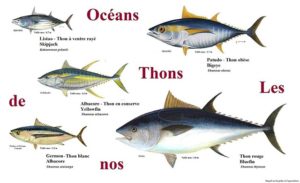
The chemical composition of tuna
Tuna is a healthy and affordable source of omega-3 fatty acids and makes a good addition to your diet. These substances are a type of polyunsaturated fat found only in fish, nuts, and seeds.
The health benefits are also provided by the content of vitamins, minerals and organic compounds. They include antioxidants and proteins, and fish is free of highly saturated fat or sodium. It also has impressive levels of selenium, phosphorus, iron, magnesium, and potassium. In terms of vitamins, there is a high amount of vitamin B12 and niacin, as well as good B6 and riboflavin.
Nutritional value and calorie content of tuna
The calorie content of raw tuna fillet is 91 kcal per 100 grams. Accordingly, sashimi from this fish has the same energy value. Other cooking methods increase the calorie content of tuna by 100 grams:
|
Cooking method |
Kcal per 100 g |
|
boiled |
140 |
|
baked in the oven |
106 |
|
steamed |
103 |
|
stewed in its own juice |
96 |
|
fried without oil |
195 |
|
fried in oil |
236 |
|
smoked |
139 |
|
canned in its own juice |
93 |
|
canned in oil |
169 |
Which type of tuna cooking is best for you? The answer depends on your budget and taste. Many gourmets prefer the taste of fried fish. Weight watchers or dieters are likely to choose healthier ways to process the product. And some believe that canned fish is more economical, easier to store, stays fresh longer and can be a convenient snack.

Why tuna is useful for the body
The benefits of tuna are as follows. It is known that acids Omega-3contained in it contribute to good heart health. According to doctors, these fish oils can help lower blood triglyceride levels, reduce arrhythmias (irregular heartbeats), and slow the buildup of plaque in arteries. We can say that these are unique properties.
For the cardiovascular system
The most famous beneficial property attributed to this fish is its significant effect on heart health. Tuna meat is highly beneficial due to its high levels of Omega-3 fatty acids, which help reduce the concentration of Omega-6 and LDL (or bad cholesterol) acids in arteries and blood vessels. Plus, it often replaces foods high in saturated fat in the diet, further reducing the risk of heart disease.
The beneficial fatty acids in fish help lower blood pressure. The potassium in tuna is a vasodilator. Relief of symptoms of hypertension can significantly improve health by reducing stress on the cardiovascular system. This will help prevent heart attacks and strokes, as well as diseases such as atherosclerosis.
For the brain and nervous system
A diet rich in tuna meat improves cognitive function in the brain. Omega-3 acids are responsible for these beneficial properties. Blood and cells are better filled with oxygen and circulate to the brain. Thanks to these properties, the organ functions much better.
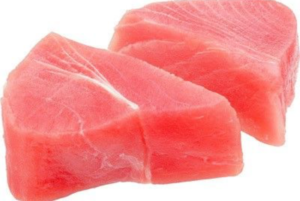
For visual acuity
Rich in fatty acids, tuna is a great food for preventing eye disorders like age-related macular degeneration. This disease is the main cause of blindness in older people. Blindness can also be caused by diabetic complications. The properties of tuna can help reduce the risks of diabetic retinopathy.
For cancer prevention
Fish has antioxidant properties thanks to selenium and other nutrients. This makes it effective and helpful in preventing certain types of cancer. Numerous studies have linked tuna to a reduction in breast and kidney cancers.
Selenium is a powerful antioxidant that neutralizes free radicals before they can cause mutations in healthy cells, turning them into cancerous ones. Other research results have also shown a decrease in the incidence of colon cancer.
For immunity
The product contains high amounts of vitamin C, zinc and manganese, each of which is believed to have antioxidant properties in nature. Antioxidants are one of the body's defense mechanisms against free radicals - harmful byproducts of cellular metabolism that cause cancer and other chronic diseases. However, selenium is a real beneficial agent in improving the functioning of the immune system. Fish is rich in this mineral, providing nearly 200% of your daily requirement in one serving. These properties make tuna a very powerful antioxidant and immunomodulatory food.
For the musculoskeletal system
The product can reduce inflammation thanks to vitamins and minerals with anti-inflammatory properties. This ensures that all organs function perfectly and helps prevent diseases such as arthritis and gout.
The benefits of tuna for the musculoskeletal system are also as follows. One of the main components of its meat is protein. This fish is one of the richest in protein meats, making it an ideal food for muscle development and fat loss.
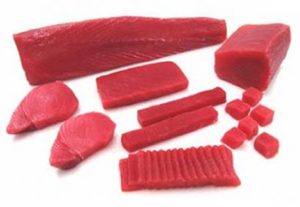
With depression
Consuming tuna is beneficial for relieving symptoms of depression. Research results indicate that its use may be beneficial for women's mental health. The benefits of tuna can also reduce depression in men.
Tuna for weight loss
The properties of tuna meat are also unique in this case. Fish of this family are low in calories and fat, but they are literally loaded with useful nutrients. The omega-3 fatty acids found in the product stimulate the production of a hormone called leptin, which balances the body's food intake. This can reduce overeating and achieve optimal saturation of the body with what is actually needed.
Can pregnant and lactating women eat tuna?
It is believed that the benefits of tuna for pregnant and lactating women are obvious as it is a good source of protein and minerals. But you should choose “healthy” fish cooking methods and limit the amount. In addition, there is evidence that tuna can be harmful due to its high mercury levels. These arguments are not fully supported, but it is better to be careful.
In order not to harm the body, you should not eat more than two natural tuna steaks per week (about 140 grams in weight) or 4 cans of fish canned in their own juice.
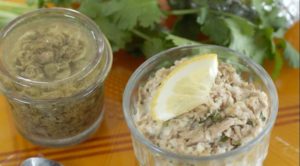
At what age children can be given tuna
As noted above, tuna is high in protein.A single 165g serving covers over 80% of the daily requirement for this macronutrient. In addition, vitamin D found in fish is a major component for bone development.
As soon as the baby reaches 6 months of age, you can introduce this fish into his diet. Many parents avoid this fish in their children's diets because they are concerned about the risk of harm from the mercury accumulated in the meat. However, a small amount of tuna eaten from time to time can benefit a child's health without putting it at risk.
According to the data obtained, a child weighing about 10 kg can safely and without harm to health eat a can of tuna every three weeks. You just need to divide the fish into portions and grind in mashed potatoes. It is ideal to combine shredded tuna with mashed vegetables.
Is tuna good for diabetes and pancreatitis?
People with diabetes can greatly benefit from eating tuna. Omega-3 acids help maintain normal insulin, which facilitates the patient's daily activities. Such properties mean that with diabetes it is not only possible but necessary to eat.
The benefits of tuna pâté are also obvious for pancreatitis. With this disease, a strict diet is prescribed that excludes any fatty foods. Because tuna is very low in fat, its benefits for sufferers are undeniable.
The benefits and harms of canned tuna
Canned tuna is a convenient way to eat healthy foods. Each serving of these canned food, which contains oil or water, contains about 30 grams of protein. According to doctors, this amount corresponds to approximately 50 percent of the recommended daily intake of this macronutrient for a person weighing 70 kg. What is the use of canned tuna meat?
Tuna is a beneficial source of complete protein that provides all 10 amino acids the body needs to maintain healthy tissue, brain function, and healthy hormone balance.
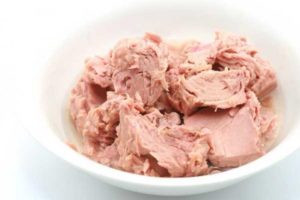
The benefits of canned fish also come from the presence of healthy fats, which the body uses to maintain healthy skin and hair, and improve cardiovascular and brain function. Fish, canned in oil, contains less of these nutrients. The benefits of tuna in oil are less, but you should not completely abandon it.
Consuming canned food can be harmful. One of the negative effects is an increase in sodium levels due to the salt it contains. This substance has negative properties. The body needs this mineral to help regulate metabolic balance, but excess sodium intake forces the body to retain water. This leads to bloating and high blood pressure. One can of canned tuna contains a quarter of the daily sodium requirement. To minimize harm, it is best to eat canned food in moderation. And of course, it is worth remembering that there is more benefit from canned tuna in its own juice.
Features of eating tuna
So, the benefits and harms of tuna for the human body are not disputed. But what's the best way to eat it? In modern stores, you can see a lot of carcasses, steaks and canned food. What to choose to maximize benefits and minimize harm?
When choosing canned fish, you need to remember one rule. When buying canned food in its own juice, the saturated fat content will be 2 grams less than in the case of a product in oil. In addition, light-colored fish contain less mercury than dark-colored ones.
How do you get more benefits from choosing fresh fish? Do not be afraid to buy tuna steaks: they cannot be harmful if it is a quality product. Make sure it's fresh: check the piece for any dark brown spots or iridescent sheen. Chilled steaks should smell like fresh ocean, not have the pungent smell of fish. In this case, the buyer will not harm himself.

Since medical advice speaks of the benefits of consuming fresh tuna once or twice a week, recipes are endless.
Even if you add oil to fish when cooking, it is still a healthier choice than fatty meats (such as beef, pork, and other popular protein options).
How to cook delicious tuna
A little creativity in the kitchen allows you to enjoy the benefits of tuna with a varied diet. You can drizzle salsa over canned fish and then use the mixture as a taco or salad filling.
It is recommended that tuna be added as an alternative to various casseroles to increase the nutrient content of the meal. Eating a piece of fish steak with brown rice as a side dish will provide your body with a lot of healthy protein and fiber. And if you cook it with spinach, you can cover the body's daily need for vitamins and minerals.

Fried tuna recipe
As noted above, the most healthy tuna dish is steak. For a simple recipe you will need:
- 2 fish steaks;
- 1 tsp kosher salt;
- 1/4 tsp cayenne pepper;
- 2 tbsp. l. olive oil;
- 1 tsp black pepper.
First, grate the tuna with salt and cayenne pepper. After that, the oil is heated in a skillet over moderate heat. Put cayenne pepper in it and fry for five minutes. After that, fillets are placed in a pan and fried for one and a half minutes on each side. An example of frying tuna fillets is shown in the video.
Canned tuna salad
Tinned tuna is best for salads. For the basic version you need:
- can of tuna in its own juice (180 grams), drain the water;
- 2 tbsp. l. minced celery;
- 2 tbsp. l. chopped red onions soaked in cold water for 5 minutes and drained;
- 1 tsp chopped parsley;
- 1/3 cup homemade mayonnaise
- 1 tbsp. l. grain mustard;
- freshly ground black pepper and freshly squeezed lemon juice (to taste).
In a small bowl, mash the tuna with a fork, then add celery, onions and parsley to it. Then you need to mix mayonnaise and mustard and season with pepper to taste, then pour the salad with the resulting dressing and stir. Drizzle with lemon juice if desired.
This salad can be very beneficial. You can add any vegetables, boiled eggs and other products to it. This means that there are many variations of dietary properties.
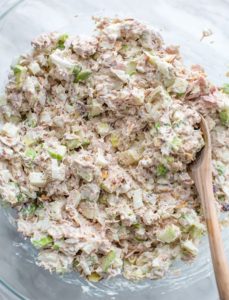
Harm of tuna and contraindications for use
Despite the many benefits and benefits of tuna fish, it should also be borne in mind that they can harm the body.
As with all types of fish, you need to be aware of the mercury content. Poisoning with this substance can cause symptoms such as memory problems, numbness, seizures, and vision problems.Some types of tuna, such as dark tuna, have higher levels of mercury.
When eating canned tuna, the sodium and table salt content should also be considered. To reduce harm, you need to choose options in your own juice and rinse the fish before adding to dishes.
To minimize harm, doctors also recommend limiting tuna consumption, especially for children and pregnant women, to about two servings a week.

How to choose and store canned tuna
When shopping for canned tuna, look for low-salt varieties in your own juice. This way you can get all the benefits of protein and good fats without eating too much sodium.
When choosing canned food with additives, you should carefully study the composition. Some of these canned foods contain ingredients rich in salt and sugar. Tuna like this in a can can be harmful.
Conclusion
As you can see, the topic of what the benefits and harms of tuna are, deserve special attention. The properties of the product are largely positive and useful.
Tuna is low in calories but high in protein, niacin, selenium, and vitamin B12. Adding it to your diet can improve weight loss, reduce inflammation, and boost brain function and thyroid health. Some types of tuna can contain a lot of mercury, so use the product in moderation.
Reviews

